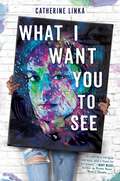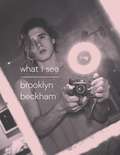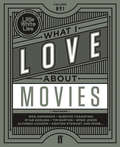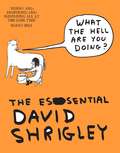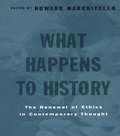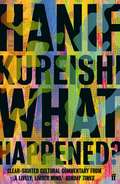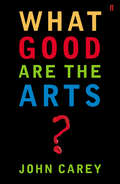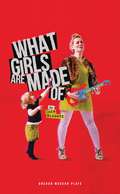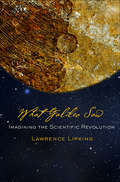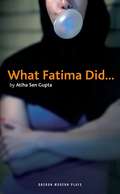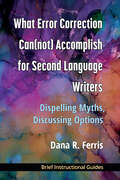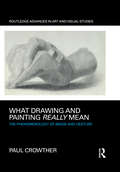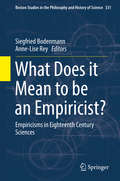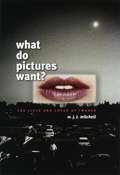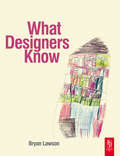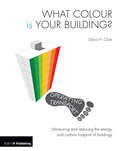- Table View
- List View
What I Want You to See
by Catherine LinkaA college freshman is swept into shaky moral territory within the cut-throat world of visual arts in this razor-sharp novel.Winning a scholarship to California's most prestigious art school seems like a fairy tale ending to Sabine Reye's awful senior year. After losing both her mother and her home, Sabine longs for a place where she belongs. But the cutthroat world of visual arts is nothing like what Sabine had imagined. Colin Krell, the renowned faculty member whom she had hoped would mentor her, seems to take merciless delight in tearing down her best work -- and warns her that she'll lose the merit-based award if she doesn't improve. Desperate and humiliated, Sabine doesn't know where to turn. Then she meets Adam, a grad student who understands better than anyone the pressures of art school. He even helps Sabine get insight on Krell by showing her the modern master's work in progress, a portrait that's sold for a million dollars sight unseen. Sabine is enthralled by the portrait; within those swirling, colorful layers of paint is the key to winning her inscrutable teacher's approval. Krell did advise her to improve her craft by copying a painting she connects with...but what would he think of Sabine secretly painting her own version of his masterpiece? And what should she do when she accidentally becomes party to a crime so well-plotted that no one knows about it but her? Complex and utterly original, What I Want You to See is a gripping tale of deception, attraction, and moral ambiguity.
What I See
by Brooklyn BeckhamWHAT I SEE, the first book by Brooklyn Beckham, is a series of snapshots of his life. Each chapter tells a different story through pictures by and of Brooklyn, accompanied by captions and passages of text in his own words. Unique, authentic and stylish, WHAT I SEE is a glimpse behind the lens.
What I Love About Movies
by Little White LiesDuring the first eight years of its existence, Little White Lies magazine has published countless interviews with some of the biggest names in the movies. Yet staff and collaborators have all been encouraged to round-off these interviews by posing a single, searching question: 'What do you love about movies?' The answers have been entertaining, profound, personal, ridiculous, revealing and unexpected, but always unique. Now, for the first time, these declarations of movie passion have been collected into the ultimate one-stop celebration of cinema, with subjects including legendary directors (Francis Ford Coppola, the Coen brothers, Wes Anderson, Steven Soderbergh, Pedro Almodóvar, Darren Aronofsky, Quentin Tarantino, Spike Jonze), as well as A-list icons (Ryan Gosling, Michael Fassbender, Kristen Stewart, Jake Gyllenhaal, Tom Hardy).Alongside these star-spangled testimonies are newly commissioned illustrations and immaculate art direction care of the award-winning LWLies creative team.
What The Hell Are You Doing?: The Essential David Shrigley
by David ShrigleyA beautifully designed and darkly comic collection of work, this book collects together the best of Shrigley's work, old and new. It is a celebration of the surreal world of one of our finest contemporary artists.
What Happens to History: The Renewal of Ethics in COntemporary Thought
by Howard MarchitelloWhile the questions of ethics have become increasingly important in recent years for many fields within the humanities, there has been no single volume that seeks to address the emergence of this concern with ethics across the disciplinary spectrum. Given this lack in currently available critical and secondary texts, and also the urgency of the issues addressed by the critics assembled here, the time is right for a collection of this nature.
What Happens to History: The Renewal of Ethics in COntemporary Thought
by Howard MarchitelloWhile the questions of ethics have become increasingly important in recent years for many fields within the humanities, there has been no single volume that seeks to address the emergence of this concern with ethics across the disciplinary spectrum. Given this lack in currently available critical and secondary texts, and also the urgency of the issues addressed by the critics assembled here, the time is right for a collection of this nature.
What Happened?
by Hanif Kureishi'No one else casts such a shrewd and gimlet eye on contemporary life.' - William Boyd Comic, dark and insightful, What Happened? is Hanif Kureishi's new collection of essays and fiction. No topic is too fringe or too mainstream for this insatiable-and much-loved-author. From social media to the ancient classics, from appraisals of David Bowie to Georges Simenon to Keith Jarrett, this is the latest literary 'event' in a unique body of work that displays Kureishi's characteristic boundless curiosity and wit. What Happened? is as much about the very fact of Kureishi's catholic appetite for culture as his observations and insights themselves, and any new book in his oeuvre is a justification for celebration.
What Good are the Arts?
by Professor John CareyFrom one of the country's most eminent reviewers and academics, a delightfully sceptical and devastatingly intelligent assessment of the true value of art.
What Girls Are Made Of (Oberon Modern Plays)
by Cora BissettIt’s 1992. In a small town in Fife, a girl is busting to get out into the world and see what's on offer. And an ad in the local paper declares: BAND SEEKS SINGER.Grunge has just gone global, scruffy indie kids are inheriting the earth, and a schoolgirl from Glenrothes is catapulted to a rock star lifestyle as the singer in a hot new indie band. Touring with Radiohead, partying with Blur, she was living the dream. Until she wasn’t.Based on her meticulously detailed, pull-no-punches teenage diaries, this is the true story of Cora Bissett’s rollercoaster journey from the girl she was to the woman she wanted to be.
What Galileo Saw: Imagining the Scientific Revolution
by Lawrence LipkingThe Scientific Revolution of the seventeenth century has often been called a decisive turning point in human history. It represents, for good or ill, the birth of modern science and modern ways of viewing the world. In What Galileo Saw, Lawrence Lipking offers a new perspective on how to understand what happened then, arguing that artistic imagination and creativity as much as rational thought played a critical role in creating new visions of science and in shaping stories about eye-opening discoveries in cosmology, natural history, engineering, and the life sciences. When Galileo saw the face of the Moon and the moons of Jupiter, Lipking writes, he had to picture a cosmos that could account for them. Kepler thought his geometry could open a window into the mind of God. Francis Bacon's natural history envisioned an order of things that would replace the illusions of language with solid evidence and transform notions of life and death. Descartes designed a hypothetical "Book of Nature" to explain how everything in the universe was constructed. Thomas Browne reconceived the boundaries of truth and error. Robert Hooke, like Leonardo, was both researcher and artist; his schemes illuminate the microscopic and the macrocosmic. And when Isaac Newton imagined nature as a coherent and comprehensive mathematical system, he redefined the goals of science and the meaning of genius. What Galileo Saw bridges the divide between science and art; it brings together Galileo and Milton, Bacon and Shakespeare. Lipking enters the minds and the workshops where the Scientific Revolution was fashioned, drawing on art, literature, and the history of science to reimagine how perceptions about the world and human life could change so drastically, and change forever.
What Fatima Did (Oberon Modern Plays)
by Atiha Sen GuptaFatima Merchant is feisty and strong-willed. At 17, she drinks, smokes and parties. On the eve of her 18th birthday, without word or warning or explanation, she adopts the hijab. Suddenly, to her friends and family she is no longer the Fatima they thought they knew. What Fatima Did... is a funny and provocative exploration of attitudes to identity, freedom and multiculturalism in contemporary London.
What Error Correction Can(not) Accomplish for Second Language Writers: DIspelling Myths, Discussing Options
by Dana R. FerrisThis book looks at aspects of L2 research that influence error correction, finding that second language acquisition takes time and that second language writers' texts differ from those written by native English speakers. Using this research, Dana R. Ferris dispels the myth that diligent teacher correction and student editing can lead to perfect, error-free texts. In clear and simple terms, Ferris makes six suggestions for things teachers can do in the classroom regarding error correction and provides samples. Other issues regarding the expectations of students and others—such as in timed (high-stakes) situations—as it relates to "perfect" papers are examined. The book closes by addressing the basic principles of developing students' language skills in second language/ESL writing classes.
What Drawing and Painting Really Mean: The Phenomenology of Image and Gesture (Routledge Advances in Art and Visual Studies)
by Paul CrowtherThere are as many meanings to drawing and painting as there are cultural contexts for them to exist in. But this is not the end of the story. Drawings and paintings are made, and in their making embody unique meanings that transform our perception of space-time and sense of finitude. These meanings have not been addressed by art history or visual studies hitherto, and have only been considered indirectly by philosophers (mainly in the phenomenological tradition). If these intrinsic meanings are explained and further developed, then the philosophy of art practice is significantly enhanced. The present work, accordingly, is a phenomenology of how the gestural and digital creation of visual imagery generates self-transformation through aesthetic space.
What Drawing and Painting Really Mean: The Phenomenology of Image and Gesture (Routledge Advances in Art and Visual Studies)
by Paul CrowtherThere are as many meanings to drawing and painting as there are cultural contexts for them to exist in. But this is not the end of the story. Drawings and paintings are made, and in their making embody unique meanings that transform our perception of space-time and sense of finitude. These meanings have not been addressed by art history or visual studies hitherto, and have only been considered indirectly by philosophers (mainly in the phenomenological tradition). If these intrinsic meanings are explained and further developed, then the philosophy of art practice is significantly enhanced. The present work, accordingly, is a phenomenology of how the gestural and digital creation of visual imagery generates self-transformation through aesthetic space.
What Does it Mean to be an Empiricist?: Empiricisms in Eighteenth Century Sciences (Boston Studies in the Philosophy and History of Science #331)
by Siegfried Bodenmann Anne-Lise ReyThis book begins with an observation: At the time when empiricism arose and slowly established itself, the word itself had not yet been coined. Hence the central question of this volume: What does it mean to conduct empirical science in early modern Europe? How can we catch the elusive figure of the empiricist?Our answer focuses on the practices established by representative scholars. This approach allows us to demonstrate two things. First, that empiricism is not a monolith but exists in a plurality of forms. Today’s understanding of the empirical sciences was gradually shaped by the exchanges among scholars combining different traditions, world views and experimental settings. Second, the long proclaimed antagonism between empiricism and rationalism is not the whole story. Our case studies show that a very fruitful exchange between both systems of thought occurred. It is a story of integration, appropriation and transformation more than one of mere opposition. We asked twelve authors to explore these fascinating new facets of empiricisms. The plurality of their voices mirrors the multiple faces of the concept itself. Every contribution can be understood as a piece of a much larger puzzle. Together, they help us better understand the emergence of empiricism and the inventiveness of the scientific enterprise.
What Do Pictures Want?: The Lives and Loves of Images
by W. J. MitchellWhy do we have such extraordinarily powerful responses toward the images and pictures we see in everyday life? Why do we behave as if pictures were alive, possessing the power to influence us, to demand things from us, to persuade us, seduce us, or even lead us astray? According to W. J. T. Mitchell, we need to reckon with images not just as inert objects that convey meaning but as animated beings with desires, needs, appetites, demands, and drives of their own. What Do Pictures Want? explores this idea and highlights Mitchell's innovative and profoundly influential thinking on picture theory and the lives and loves of images. Ranging across the visual arts, literature, and mass media, Mitchell applies characteristically brilliant and wry analyses to Byzantine icons and cyberpunk films, racial stereotypes and public monuments, ancient idols and modern clones, offensive images and found objects, American photography and aboriginal painting. Opening new vistas in iconology and the emergent field of visual culture, he also considers the importance of Dolly the Sheep—who, as a clone, fulfills the ancient dream of creating a living image—and the destruction of the World Trade Center on 9/11, which, among other things, signifies a new and virulent form of iconoclasm. What Do Pictures Want? offers an immensely rich and suggestive account of the interplay between the visible and the readable. A work by one of our leading theorists of visual representation, it will be a touchstone for art historians, literary critics, anthropologists, and philosophers alike. “A treasury of episodes—generally overlooked by art history and visual studies—that turn on images that ‘walk by themselves’ and exert their own power over the living.”—Norman Bryson, Artforum
What Do Pictures Want?: The Lives and Loves of Images (Prehistoric Archeology And Ecology Ser.)
by W. J. MitchellWhy do we have such extraordinarily powerful responses toward the images and pictures we see in everyday life? Why do we behave as if pictures were alive, possessing the power to influence us, to demand things from us, to persuade us, seduce us, or even lead us astray? According to W. J. T. Mitchell, we need to reckon with images not just as inert objects that convey meaning but as animated beings with desires, needs, appetites, demands, and drives of their own. What Do Pictures Want? explores this idea and highlights Mitchell's innovative and profoundly influential thinking on picture theory and the lives and loves of images. Ranging across the visual arts, literature, and mass media, Mitchell applies characteristically brilliant and wry analyses to Byzantine icons and cyberpunk films, racial stereotypes and public monuments, ancient idols and modern clones, offensive images and found objects, American photography and aboriginal painting. Opening new vistas in iconology and the emergent field of visual culture, he also considers the importance of Dolly the Sheep—who, as a clone, fulfills the ancient dream of creating a living image—and the destruction of the World Trade Center on 9/11, which, among other things, signifies a new and virulent form of iconoclasm. What Do Pictures Want? offers an immensely rich and suggestive account of the interplay between the visible and the readable. A work by one of our leading theorists of visual representation, it will be a touchstone for art historians, literary critics, anthropologists, and philosophers alike. “A treasury of episodes—generally overlooked by art history and visual studies—that turn on images that ‘walk by themselves’ and exert their own power over the living.”—Norman Bryson, Artforum
What Do Pictures Want?: The Lives and Loves of Images
by W. J. MitchellWhy do we have such extraordinarily powerful responses toward the images and pictures we see in everyday life? Why do we behave as if pictures were alive, possessing the power to influence us, to demand things from us, to persuade us, seduce us, or even lead us astray? According to W. J. T. Mitchell, we need to reckon with images not just as inert objects that convey meaning but as animated beings with desires, needs, appetites, demands, and drives of their own. What Do Pictures Want? explores this idea and highlights Mitchell's innovative and profoundly influential thinking on picture theory and the lives and loves of images. Ranging across the visual arts, literature, and mass media, Mitchell applies characteristically brilliant and wry analyses to Byzantine icons and cyberpunk films, racial stereotypes and public monuments, ancient idols and modern clones, offensive images and found objects, American photography and aboriginal painting. Opening new vistas in iconology and the emergent field of visual culture, he also considers the importance of Dolly the Sheep—who, as a clone, fulfills the ancient dream of creating a living image—and the destruction of the World Trade Center on 9/11, which, among other things, signifies a new and virulent form of iconoclasm. What Do Pictures Want? offers an immensely rich and suggestive account of the interplay between the visible and the readable. A work by one of our leading theorists of visual representation, it will be a touchstone for art historians, literary critics, anthropologists, and philosophers alike. “A treasury of episodes—generally overlooked by art history and visual studies—that turn on images that ‘walk by themselves’ and exert their own power over the living.”—Norman Bryson, Artforum
What Do Pictures Want?: The Lives and Loves of Images
by W. J. MitchellWhy do we have such extraordinarily powerful responses toward the images and pictures we see in everyday life? Why do we behave as if pictures were alive, possessing the power to influence us, to demand things from us, to persuade us, seduce us, or even lead us astray? According to W. J. T. Mitchell, we need to reckon with images not just as inert objects that convey meaning but as animated beings with desires, needs, appetites, demands, and drives of their own. What Do Pictures Want? explores this idea and highlights Mitchell's innovative and profoundly influential thinking on picture theory and the lives and loves of images. Ranging across the visual arts, literature, and mass media, Mitchell applies characteristically brilliant and wry analyses to Byzantine icons and cyberpunk films, racial stereotypes and public monuments, ancient idols and modern clones, offensive images and found objects, American photography and aboriginal painting. Opening new vistas in iconology and the emergent field of visual culture, he also considers the importance of Dolly the Sheep—who, as a clone, fulfills the ancient dream of creating a living image—and the destruction of the World Trade Center on 9/11, which, among other things, signifies a new and virulent form of iconoclasm. What Do Pictures Want? offers an immensely rich and suggestive account of the interplay between the visible and the readable. A work by one of our leading theorists of visual representation, it will be a touchstone for art historians, literary critics, anthropologists, and philosophers alike. “A treasury of episodes—generally overlooked by art history and visual studies—that turn on images that ‘walk by themselves’ and exert their own power over the living.”—Norman Bryson, Artforum
What Do Pictures Want?: The Lives and Loves of Images (Prehistoric Archeology And Ecology Ser.)
by W. J. MitchellWhy do we have such extraordinarily powerful responses toward the images and pictures we see in everyday life? Why do we behave as if pictures were alive, possessing the power to influence us, to demand things from us, to persuade us, seduce us, or even lead us astray? According to W. J. T. Mitchell, we need to reckon with images not just as inert objects that convey meaning but as animated beings with desires, needs, appetites, demands, and drives of their own. What Do Pictures Want? explores this idea and highlights Mitchell's innovative and profoundly influential thinking on picture theory and the lives and loves of images. Ranging across the visual arts, literature, and mass media, Mitchell applies characteristically brilliant and wry analyses to Byzantine icons and cyberpunk films, racial stereotypes and public monuments, ancient idols and modern clones, offensive images and found objects, American photography and aboriginal painting. Opening new vistas in iconology and the emergent field of visual culture, he also considers the importance of Dolly the Sheep—who, as a clone, fulfills the ancient dream of creating a living image—and the destruction of the World Trade Center on 9/11, which, among other things, signifies a new and virulent form of iconoclasm. What Do Pictures Want? offers an immensely rich and suggestive account of the interplay between the visible and the readable. A work by one of our leading theorists of visual representation, it will be a touchstone for art historians, literary critics, anthropologists, and philosophers alike. “A treasury of episodes—generally overlooked by art history and visual studies—that turn on images that ‘walk by themselves’ and exert their own power over the living.”—Norman Bryson, Artforum
What Do Pictures Want?: The Lives and Loves of Images
by W. J. MitchellWhy do we have such extraordinarily powerful responses toward the images and pictures we see in everyday life? Why do we behave as if pictures were alive, possessing the power to influence us, to demand things from us, to persuade us, seduce us, or even lead us astray? According to W. J. T. Mitchell, we need to reckon with images not just as inert objects that convey meaning but as animated beings with desires, needs, appetites, demands, and drives of their own. What Do Pictures Want? explores this idea and highlights Mitchell's innovative and profoundly influential thinking on picture theory and the lives and loves of images. Ranging across the visual arts, literature, and mass media, Mitchell applies characteristically brilliant and wry analyses to Byzantine icons and cyberpunk films, racial stereotypes and public monuments, ancient idols and modern clones, offensive images and found objects, American photography and aboriginal painting. Opening new vistas in iconology and the emergent field of visual culture, he also considers the importance of Dolly the Sheep—who, as a clone, fulfills the ancient dream of creating a living image—and the destruction of the World Trade Center on 9/11, which, among other things, signifies a new and virulent form of iconoclasm. What Do Pictures Want? offers an immensely rich and suggestive account of the interplay between the visible and the readable. A work by one of our leading theorists of visual representation, it will be a touchstone for art historians, literary critics, anthropologists, and philosophers alike. “A treasury of episodes—generally overlooked by art history and visual studies—that turn on images that ‘walk by themselves’ and exert their own power over the living.”—Norman Bryson, Artforum
What Designers Know
by Bryan LawsonEach chapter deals with a different technique from which we can best represent and make explicit the forms of knowledge used by designers. The book explores whether design knowledge is special, and attempts to get to the root of where design knowledge comes from. Crucially, it focuses on how designers use drawings in communicating their ideas and how they ‘converse’ with them as their designs develop. It also shows how experienced designers use knowledge differently to novices suggesting that design ‘expertise’ can be developed. Overall, this book builds a layout of the kinds of skill, knowledge and understanding that make up what we call designing.
What Designers Know
by Bryan LawsonEach chapter deals with a different technique from which we can best represent and make explicit the forms of knowledge used by designers. The book explores whether design knowledge is special, and attempts to get to the root of where design knowledge comes from. Crucially, it focuses on how designers use drawings in communicating their ideas and how they ‘converse’ with them as their designs develop. It also shows how experienced designers use knowledge differently to novices suggesting that design ‘expertise’ can be developed. Overall, this book builds a layout of the kinds of skill, knowledge and understanding that make up what we call designing.
What Colour is your Building?: Measuring and reducing the energy and carbon footprint of buildings
by David ClarkDefining and reducing the carbon footprint of a new or refurbished building can be a daunting task. There are lots of tools to measure the environmental impact of buildings, but they all measure energy and CO2 in different ways, and they do not measure the whole carbon footprint. What Colour is your Building? provides practical and pragmatic guidance on how to calculate and then compare the whole carbon footprint of buildings using one simple method looking at operating, embodied and transport energy. It will equip designers, building owners, occupiers, planners and policy makers with the tools and knowledge that they will need to make decisions early on about where the big impacts will be in terms of reducing the carbon footprint of the building, including: A new, simple approach to understanding the whole carbon impact of buildings Benchmarking data for operating energy performance A clear, transparent method of separating landlord energy performance from tenant energy performance Simple diagrams and numbers to put renewable energy into perspective.
What Colour is your Building?: Measuring and reducing the energy and carbon footprint of buildings
by David ClarkDefining and reducing the carbon footprint of a new or refurbished building can be a daunting task. There are lots of tools to measure the environmental impact of buildings, but they all measure energy and CO2 in different ways, and they do not measure the whole carbon footprint. What Colour is your Building? provides practical and pragmatic guidance on how to calculate and then compare the whole carbon footprint of buildings using one simple method looking at operating, embodied and transport energy. It will equip designers, building owners, occupiers, planners and policy makers with the tools and knowledge that they will need to make decisions early on about where the big impacts will be in terms of reducing the carbon footprint of the building, including: A new, simple approach to understanding the whole carbon impact of buildings Benchmarking data for operating energy performance A clear, transparent method of separating landlord energy performance from tenant energy performance Simple diagrams and numbers to put renewable energy into perspective.
